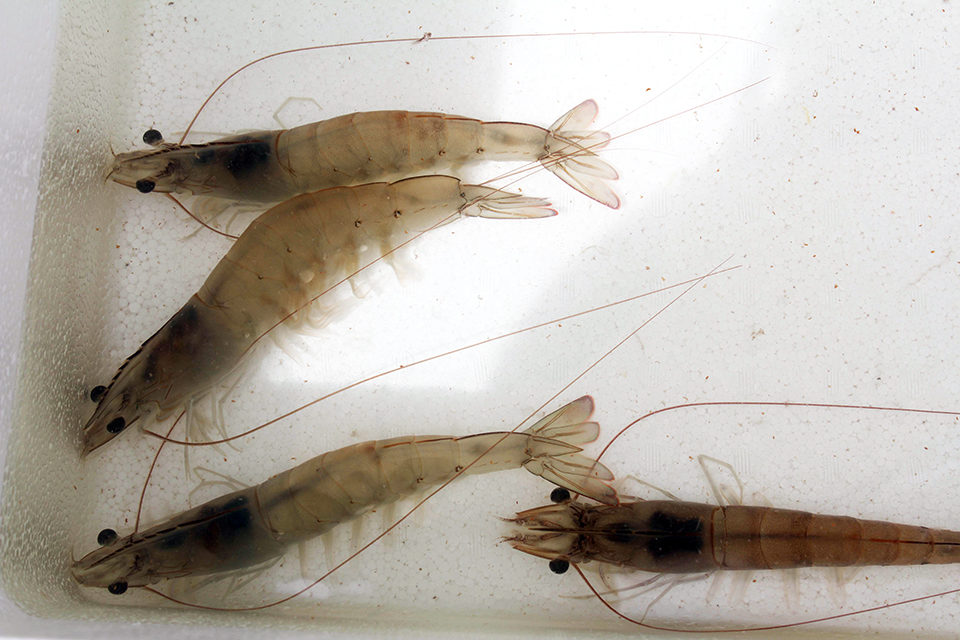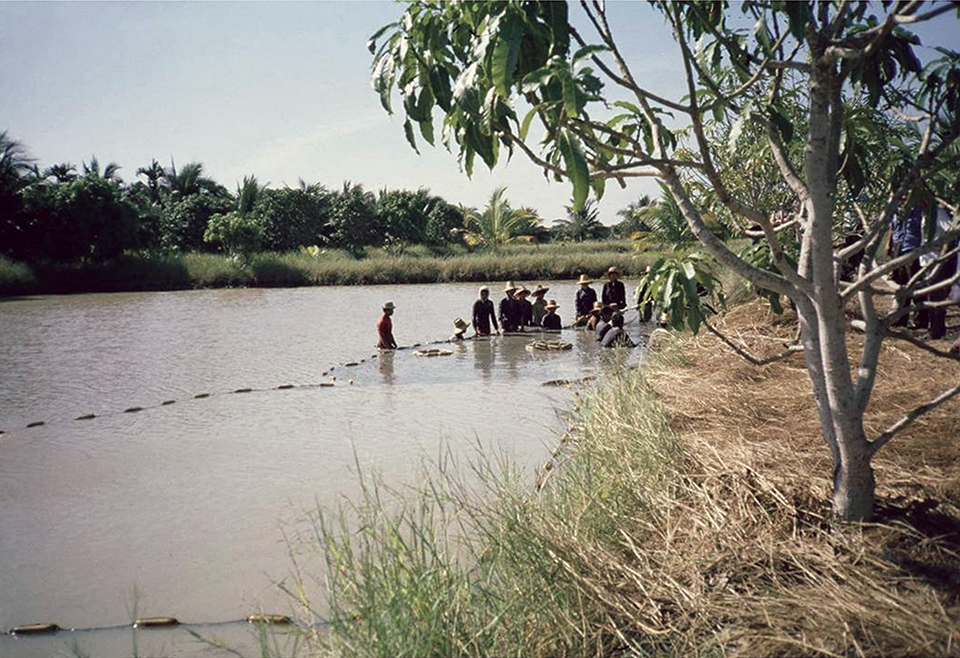To understand diseases like EMS, it’s important to ask the right questions

Few would disagree that disease is the top problem affecting aquaculture operations, regardless of species. Disease can occur due to many different things. Those charged with determining the underlying cause of a disease outbreak have a wide variety of tools at their disposal. Disease diagnosis is in many respects detective work.
Disease
Disease is defined in the simplest terms as a deviation from normal physiological functioning. It ranges from benign with little or no impact to insidious with huge and rapid impacts.
Most people link disease with pathogens such as viruses, bacteria, fungi or protozoa. Indeed, the vast majority of identifiable causes of mortality in aquaculture are a result of infections with biological agents. However, disease can also be the result of many other things acting alone or together. Disease-causing agents include algal and fungal toxins, chemicals, metals, nutritional factors and environmental factors.
Shrimp diseases
Shrimp farming has grown rapidly over the last few decades, and along with this growth came some serious disease problems. The worst outbreaks are viral in origin, although bacterial pathogens likely have a significant role in viral susceptibility and disease processes. The role of stress is undisputed, and the failure of many aquaculturists to appreciate what constitutes stress is responsible for many problems that in hindsight were preventable. Far too many farmers fail to use the tools of science, and many of the lessons learned with terrestrial animals are ignored.
As developing nations realized that shrimp can be an important source of foreign currency, industrial growth has been encouraged. All too often, though, the growth has been driven by a gold rush mentality with many farmers not really understanding what they are doing, only that for some it has been a boon, and they want the same thing. This is not sustainable and in the long run will cull out those who should not be farming shrimp.
The industry is now seeing a widespread problem that is apparently pathologically consistent, but has resisted ready determination of the underlying cause. Termed early morality syndrome (EMS) or hepatopancreatic necrosis syndrome, it is spreading, and there do not appear to be any immediate solutions in sight.
There is no shortage of opinions as to the causes of EMS, accompanied by the usual finger pointing and some solid science. Ultimately, though, to protect against a problem, knowing exactly what causes it is critical for developing successful mitigation strategies.
Right questions
Asking the right questions and piecing the answers together are important for determining what actually is occurring regarding diseases.
Where is the disease occurring?
This means geographically as well as temporally, and in what part of the life cycle. Histopathology of affected animals is the only viable tool to assure that what occurs in one place is in fact the same problem reported elsewhere.
What are the common features of the observed process and the animals?
Look for consistent features of the disease process. Do they all come from a similar source, such as the same hatchery? Is there any backward link to a consistent feature?
Can the pathology be replicated under controlled conditions?
Exposing normal animals to tissue extracts from animals that are dying is a common pathology approach. Using filtered, heated or chemically treated extracts can be revealing as to possible causes.
Are culture practices consistent between confirmed outbreaks?
An example of this might be that the water used in the ponds is all from a certain body of water. Another example might be the use of a chemical disinfectant or some other method of treating the water before animals are stocked.
When conditions are replicated in ponds, can the impacts be mitigated?
An example of this might be stocking animals in cages that are not in contact with sediments, or perhaps stocking and growing animals to larger sizes under highly bio-secure, low-stress rearing conditions.
What are the consistencies and differences between outbreaks in different areas?
This requires a concerted effort to eliminate anecdotes and hearsay from the process.
Have changes occurred in environments that might underlie the process?
Pollution of nearshore estuaries and similar marine environments seems an inevitable consequence of human activities. This pollution can take many forms. Perhaps the single greatest threat globally is the failure to treat sewage, resulting in eutrophication of localized areas. The number of dead zones directly attributable to this is increasing and can result in toxic strains of algae proliferating over widespread areas.
Do changes in water quality parameters contribute to a problem?
An example of this is the recent observation that pH changes have adversely affected the ability of certain larval bivalve species to reproduce.
Perspectives
These are only a few of the more important considerations – a complete detailing of which is far beyond the scope of this article. At this time, a lot of minds are working on determining the cause of the current EMS problem affecting farmed shrimp. This is an arduous process that may take years to identify a final, universally accepted cause. Sometimes, despite all efforts, the underlying causes of diseases remain unknown. Yet eventually, a consistent, rigorous, science-based strategy will likely lead to understanding of the causes of disease problems and hopefully offer potential solutions. Strategies that allow the process to be mitigated will become apparent as research hones in on likely causes.
(Editor’s Note: This article was originally published in the September/October 2012 print edition of the Global Aquaculture Advocate.)
Now that you've reached the end of the article ...
… please consider supporting GSA’s mission to advance responsible seafood practices through education, advocacy and third-party assurances. The Advocate aims to document the evolution of responsible seafood practices and share the expansive knowledge of our vast network of contributors.
By becoming a Global Seafood Alliance member, you’re ensuring that all of the pre-competitive work we do through member benefits, resources and events can continue. Individual membership costs just $50 a year.
Not a GSA member? Join us.
Author
-
Stephen G. Newman, Ph.D.
6722 162nd Place Southwest
Lynnwood, Washington
98037-2716 USA[109,111,99,46,104,99,101,116,45,110,105,45,97,117,113,97,64,109,119,101,110,103,115]
Tagged With
Related Posts

Health & Welfare
‘Big picture’ connects shrimp disease, inbreeding
Disease problems on shrimp farms may be partly driven by an interaction between management practices that cause inbreeding in small hatcheries and the amplification by inbreeding of susceptibility to disease and environmental stresses.

Health & Welfare
A comprehensive look at the Proficiency Test for farmed shrimp
The University of Arizona Aquaculture Pathology Laboratory has carried out the Proficiency Test (PT) since 2005, with 300-plus diagnostic laboratories participating while improving their capabilities in the diagnosis of several shrimp pathogens.

Health & Welfare
A holistic management approach to EMS
Early Mortality Syndrome has devastated farmed shrimp in Asia and Latin America. With better understanding of the pathogen and the development and improvement of novel strategies, shrimp farmers are now able to better manage the disease.

Aquafeeds
A look at protease enzymes in crustacean nutrition
Food digestion involves digestive enzymes to break down polymeric macromolecules and facilitate nutrient absorption. Enzyme supplementation in aquafeeds is a major alternative to improve feed quality and nutrient digestibility, gut health, compensate digestive enzymes when needed, and may also improve immune responses.



